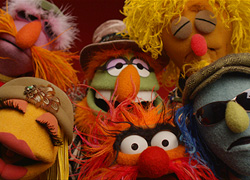I've not seen a digital projection yet - I think the nearest cinema to me with the equipment is Manchester, and the new trilogy wasn't worth the trip.

However, I would have thought that you'd still have some flicker there - it's still being scanned serially.
Personally, I prefer the more immediate 'live' look of interlaced video. I've worked with analogue video for about 12 years now, and digital for the last three. I'm currently working on digital restoration of old analogue videotapes, which is an interesting challenge!



 Welcome to the Muppet Central Forum!
Welcome to the Muppet Central Forum! Back to the Rock Season 2
Back to the Rock Season 2 Sesame Street Season 54
Sesame Street Season 54 The Muppets Mayhem premieres
The Muppets Mayhem premieres Bear arrives on Disney+
Bear arrives on Disney+ Sam and Friends Book
Sam and Friends Book